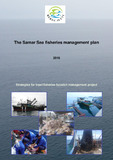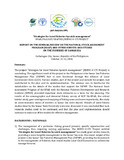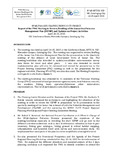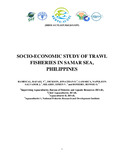| dc.description | Samar Sea is situated between southern Luzon and eastern Visayas in the Philippines. It is bordered by the provinces of (Western) Samar to the east, Leyte to the south, Masbate to the west, and Northern Samar to the north. It is connected to the Philippine Sea to the north via San Bernardino Strait, Leyte Gulf to the south and east via San Juanico Strait, to the Visayan Sea to the southwest, and to the Sibuyan Sea to the northwest via Masbate Passage and Ticao Passage. Several bays and inlets are found in the fringes of Samar Sea including Maqueda Bay and Carigara Gulf (Fig. 1).
The entire Samar Sea has an estimated area of 198 km2 or 150 nautical miles2, it is bounded from Tinambacan Pt. (Calbayog) and Buad Island (Zumarraga), and the area has an average depth of 15 fathoms or 28 m (Samar Sea Profile).
The greater part of Samar Sea is within the waters of the province of Samar comprising of two (2) cities and nine (9) municipalities, namely Calbayog, Catbalogan, Tagapul-an, Sto Nino, Almagro, Sta. Margarita, Gandara, Pagsanghan, Tarangnan, Daram and Zumarraga. The number of registered fisherfolk in the province was 37,567 as of July 2, 2015 (BFAR FishR), which is about 5% of the population of the province (http://samar.lgu-ph.com).Samar Sea is acknowledged to have experienced overfishing and significant degradation of marine resources. Before 1981, there were 50 commercial fish species, but within 10 years, it was reduced to only 10 due to overfishing and destructive fishing methods (like dynamite fishing), with average daily catch reduced from 30 kg/day in the 1960s, to 8 kg/day in 1981, to 3.5 kg/day in 1991 (ICLARM, 1993).The first red tide in the Philippines occurred in the Samar Sea in 1983 (Hermes, 1983) and thereafter continued to occur at irregular intervals.
This Samar Sea Fisheries Management Plan will serve as a framework for managing the fisheries of the Province of Samar, particularly on the sector of marine capture fisheries. | en |




